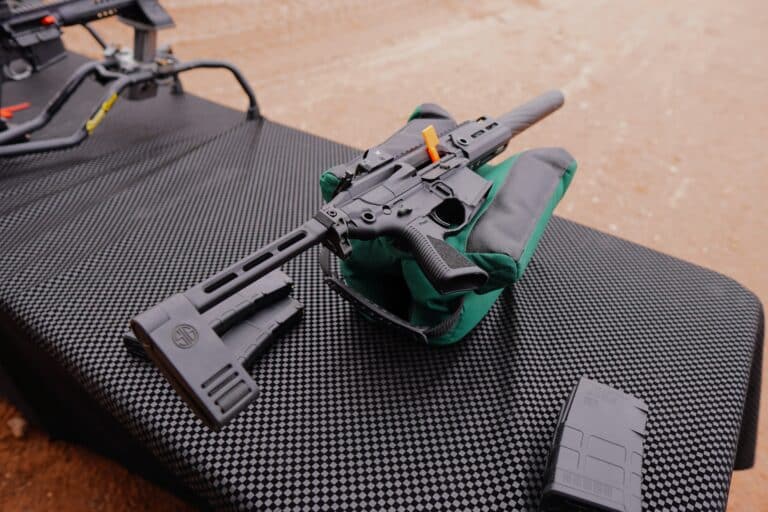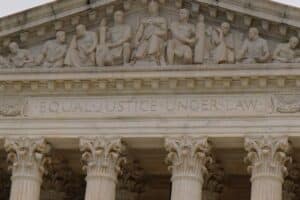President Joe Biden’s attempt to heavily restrict pistol braces was tossed this week for pushing the ATF’s authority beyond its limits. But at least one judge thinks the accessories might also be protected by the Second Amendment.
On Tuesday, Judge Don Willett of the Fifth Circuit Court of Appeals joined a ruling that found Biden’s pistol-brace ban crossed the line from enforcing current law into legislating. The majority said the rule, like several other ATF policies before it, violated the Administrative Procedure Act (APA) and can’t stand. The panel decided not to address Second Amendment claims since the plaintiffs won on their APA claim.
But Judge Willett wrote separately to contend the firearm accessories are probably protected under the right to keep and bear arms.
“Rearward attachments, besides making a pistol less concealable, improve a pistol’s stability, and thus a user’s accuracy. Accuracy, in turn, promotes safety,” Willett wrote in a concurrence. “In my view, protected Second Amendment ‘conduct’ likely includes making common, safety-improving modifications to otherwise lawfully bearable arms.”
While Willett’s framework is merely an early exploration of the issue and, as a concurrence, holds limited precedential value, it does offer insight into how other courts may confront similar issues. In particular, his focus on “safety-improving modifications” to legal firearms would seem to have implications beyond just pistol braces.
“Assault weapon” bans, for instance, are routinely drafted to differentiate certain classes of semi-automatic firearms based solely on cosmetic or ergonomic features such as pistol grips and adjustable stocks. Without such features, most weapons covered under these bans are otherwise legal to own. Yet, when equipped with them, they become prohibited despite, in many cases improving the shooting experience and, thus, stability and accuracy of the weapon for its owner. According to Willett, this distinction could implicate the Second Amendment test established by the Supreme Court in New York State Rifle and Pistol Association v. Bruen.
“Remember: ATF agrees that the weapons here are lawfully bearable pistols absent a rearward attachment. Congress might someday try to add heavy pistols to the NFA and the GCA, but it hasn’t yet. These pistols are therefore lawful,” Willett wrote. “Adding a rearward attachment—whether as a brace or a stock—makes the pistol more stable and the user more accurate. I believe these distinctions likely have constitutional significance under Bruen.”
He even cast doubt over the constitutionality of the National Firearms Act of 1934 (NFA), which regulates short-barrel rifles (SBRs), silencers, and machineguns.
“Even for attachments that convert a pistol into a rifle under the statutes, ATF has not identified any historical tradition of requiring ordinary citizens to endure a lengthy, costly, and discretionary approval process just to use accessories that make an otherwise lawful weapon safer,” he added. “Instead, the NFA tends to regulate weapons that inflict indiscriminate destruction.”
He noted that while determining conclusively whether the Biden administration’s rule violated the Second Amendment was unnecessary in this case, it was likely that “the constitutional questions may soon return.”
To be sure, even if the Second Amendment case against the ban does return, there is no guarantee that the Fifth Circuit or any other federal court will necessarily see it the same way. Indeed, there are already indications that some members of his own court do not share Judge Willett’s view. Judge Stephen A. Higginson, who authored a dissenting opinion against the panel’s holding that the ban violated the APA, also wrote separately to dispute the Second Amendment case for striking down the ban.
“I disagree that these braces are, in relevant regard, ‘safety-improving modifications,’” Higgenson wrote. “Increased concealability and accuracy, at least in the hands of killers, is not ‘safe’—it is lethal.”
Instead, Higginson relied on a combination of dicta from Heller and his interpretation of the “common use” test to arrive at the conclusion that braced pistols—deemed SBRs by the federal government—are too dangerous and unusual to be covered by the text of the Second Amendment.
“Until told otherwise by the Supreme Court, I am persuaded that uniquely dangerous weapons, including short-barreled rifles, are not covered by the Second Amendment,” he added. “That’s because there is a historical tradition of prohibiting the carrying of ‘dangerous and unusual weapons.’ And the Supreme Court’s more recent decision in Bruen left Heller’s dangerous-and-unusual carveout intact.”
But while Higginson said his objections arose from following Supreme Court precedent, he did so in a way that the current Court would likely disagree with. Reasonable legal minds can differ over whether braced pistols represent a safety improvement or are, instead, particularly dangerous. The case that they are also unusual is much harder to make.
In its impact assessment for the rule, the ATF itself estimated that three to seven million pistol braces were in civilian circulation. Meanwhile, the Congressional Research Service indicated they were far more commonly owned, with estimates of between 10 to 40 million in civilian hands.
Ultimately, it may not matter what the Second Amendment implications of the pistol brace ban actually are. The administrative law weaknesses of the ATF’s rule, much like its frame and receiver and bump stock bans, may ultimately carry the day before a Second Amendment case against the ban similar to Judge Willett’s can be fully fleshed out.
Nevertheless, Willett’s argument on Second Amendment protections for accuracy and safety-improving modifications to otherwise legal firearms offer a glimpse into how some judges might view the scope of the right to keep and bear arms. It’s an idea that could have implications far beyond pistol braces.






